I spoke to Jon and he said to think about moving parts with the cog and what I could make that is interesting. I made a mind map of different things I could look into and I decided that a thaumatrope was most interesting. I didn't know they were called this until I looked it up and now I have done this research about Thaumatrpes and then found out about Phenakistoscopes, Zoetrope and Flip Books.
Our Thaumatropes
Our Thaumatropes
The thaumatrope is among the simplest of the "persistence of vision" toys that were introduced in the early 19th century. In its basic form it is a card with a different picture on each surface and string attached to each side. When the string is wound up then released the card spins rapidly merging the two pictures together. Less common were examples like the mechanical toy below where two images of different phases of a movement caused the image to move.
The illustration on the right below is from a booklet, "Every Boy His Own Toy-Maker" published by F. M. Lupton in 1874. A PDF of this page on making a thaumatrope can be downloaded from this link.
On the left in the row below is a clockwork toy thaumatrope called a New Mechanical Cinema. Most thaumatropes do not show motion but combine two images into one. The cards for this toy show two frames of a movement. The see saw goes up and down, a pair of boxers punch as it turns. We were lucky to find one in pristine condition with its cards in a box.

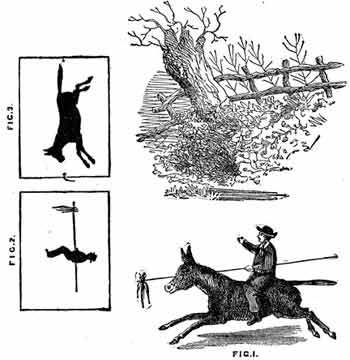
On the right is a trade card that shows the two sides of a bird and cage image while a boy illustrates the process of spinning the cards to unite the images. The combined image is seen below.
Below you see the two sides of an early 20th century thaumatrope of a horse and circus bare back rider. Below is an animation showing the merged images.



These are my new favourite things in the world. I knew about them before starting this project, but I am appreciating them a lot more now. They can be made really easily and are really fun.
The Phenakistoscope
Like the zoetrope this toy uses a series of images viewed though slits to create the animation. It differs from it because the images and slits are on rotating disks rather than in a drum. If the picture disk and disk with slits are back to back it is held in front of a mirror and the images are viewed in the mirror through the slits. The 19th century set on the right below is of this type. A variation, sometimes called a stroboscope, mounts the picture disk and the disk with slits separated on a spindle so that the pictures are viewed directly through the slits.
On the left below is is an early 20th century "Motion Picture Show" or "Ludoscope" which came in its box with a set of disks.
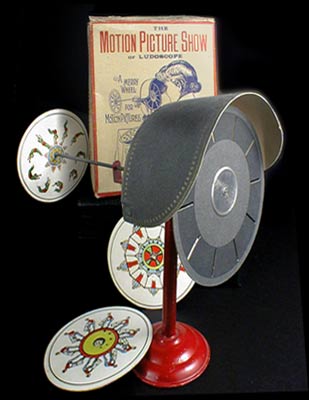

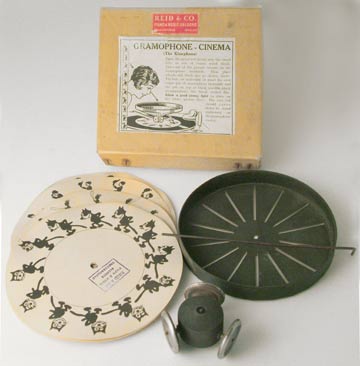
In our collection we have several viewers that work in conjunction with a record player. On the left is a "Gramophone Cinema" that can only date from the 1920s. An illustrated disk site on the top of a record and a disk with slots rides on a wooden spindle with rollers over it. As the record turns the animation can be seen through the slits. The cards include Felix the Cat and a Charlie Chaplanesk tramp.
The Zoetrope
The zoetrope is by far the best know of the "persistence of vision" toys. Invented in the early 19th century, the name is now applied to almost any drum shaped motion toy. The zoetrope is a drum with a series of slits on the upper half. A strip with the same number of images is place in the lower half of the drum. When the drum spins the slits act as shutters to show the images one at a time. Each of the images shows a slightly different part of the movement and they blend into a smooth motion.
On the left below is a large 19th century zoetrope on a red base. It holds strips as well as disk shaped cards that sit on the floor and give a second "movie".
On the right below is one of our three record player motion toys. "The Whitte's Moviescope" is called "4 in 1" because it can be used in a number of ways. The wooden spindle can be used in several configurations so that it can be hand held or sit on the record player at different heights. The delightful graphic on the box shows a family enjoying the show.

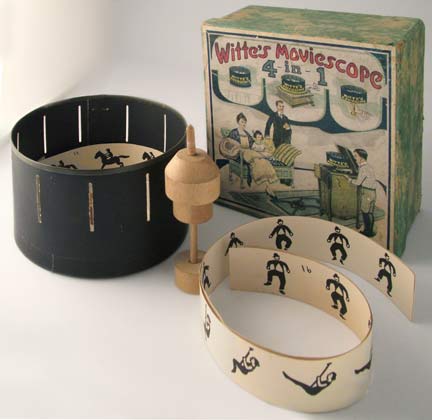
On the right is a 1905 supplement to the New York Sunday American and Journalnewspaper. A zoetrope pattern with instructions and two strips are included. You can make your own by downloading a PDF of the page and sizing it to fit your printer. Enjoy!
Today the zoetrope is available in several model kits. We have several different fast food toys like the 1996 Wendy's toy seen on the right.The base is a figural Felix the Cat and the strips are all of Felix.
Some of the Flip Books in our Collection
The flip book is a series of pages where each page shows a slightly different phase of a motion. This, of course, is the way frame by frame animation is accomplished in movie cartoons. The viewing mechanism can be as simple as your thumb or as complex as the Kinora and Mutoscope from our collection shown below.
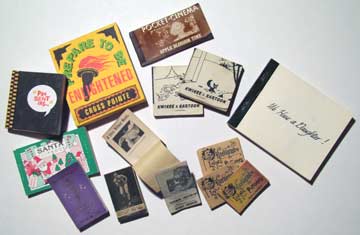
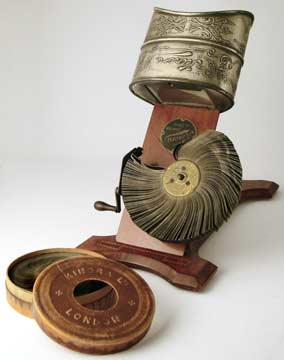
Above are a selection of our flip books which range in age from the 1890s to contemporary. They include several late 19th and early 20th century books such as a Jack Johnson boxing match, a serpentine dance, and Felix the Cat cartoons. We also collect artist's flip books like "We have a Daughter!" by Charles Swedlund, advertising and reproduction items.
While the selection of flip books shown above are viewed by fanning them past your thumb the object on the right uses a much more elaborate means of viewing. It is our Kinora viewer. This turn of the last century English viewer with a selection of flip book reels was an elegant parlor accessory and could view both commercially produced reels and amateur reels made with a special camera.
On the right is our Mutoscope, a very heavy cast iron arcade machine that contains a large flip book. Drop a penny in the slot and turn the handle and a lady in tights gives a hanging punching bag a very vigorous workout. We know that the title of this reel is "Bag Punching by Sadie Leonard" and it was published by the Mutoscope Company in 1897. This information came to us from an internet visitor to our site and we have since found the title listed in early motion pictures archives.
The picture on the far right shows the interior with the side door open. The reel of the large flip book can be seen as it slips past a block that allows the frames to be seen one at a time.
Our Mutoscope dates from the turn of the last century. It has been modified to sit on a counter rather than the original cast iron base. This was the practice for traveling shows where weight was an issue. When we bought it we thought the detail was worn and damaged but when we cleaned off layer after layer of old paint in many colors we found the detail was perfect but had been blurred and filled over the years. Restored to the color and decoration we found in the bottom layer it is a treasured part of our collection.

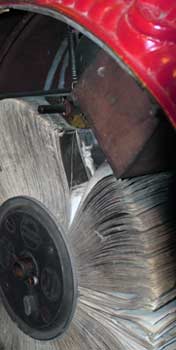

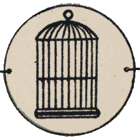
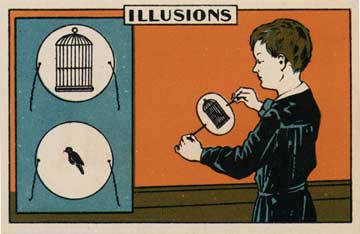
No comments:
Post a Comment